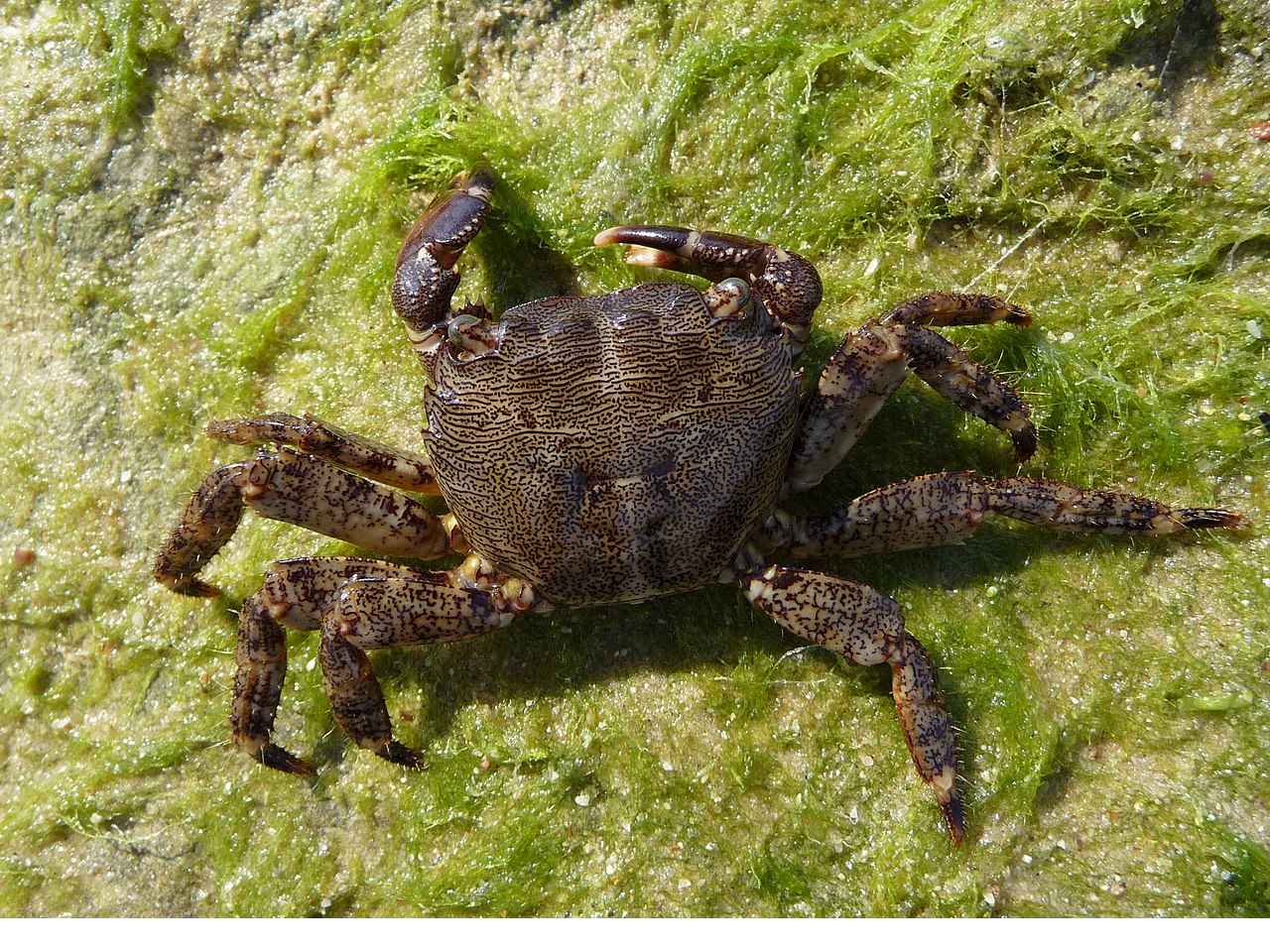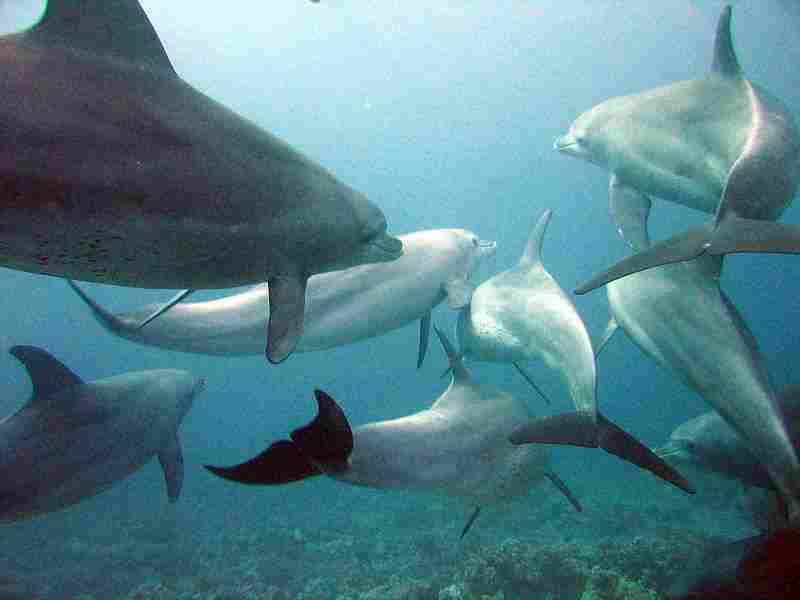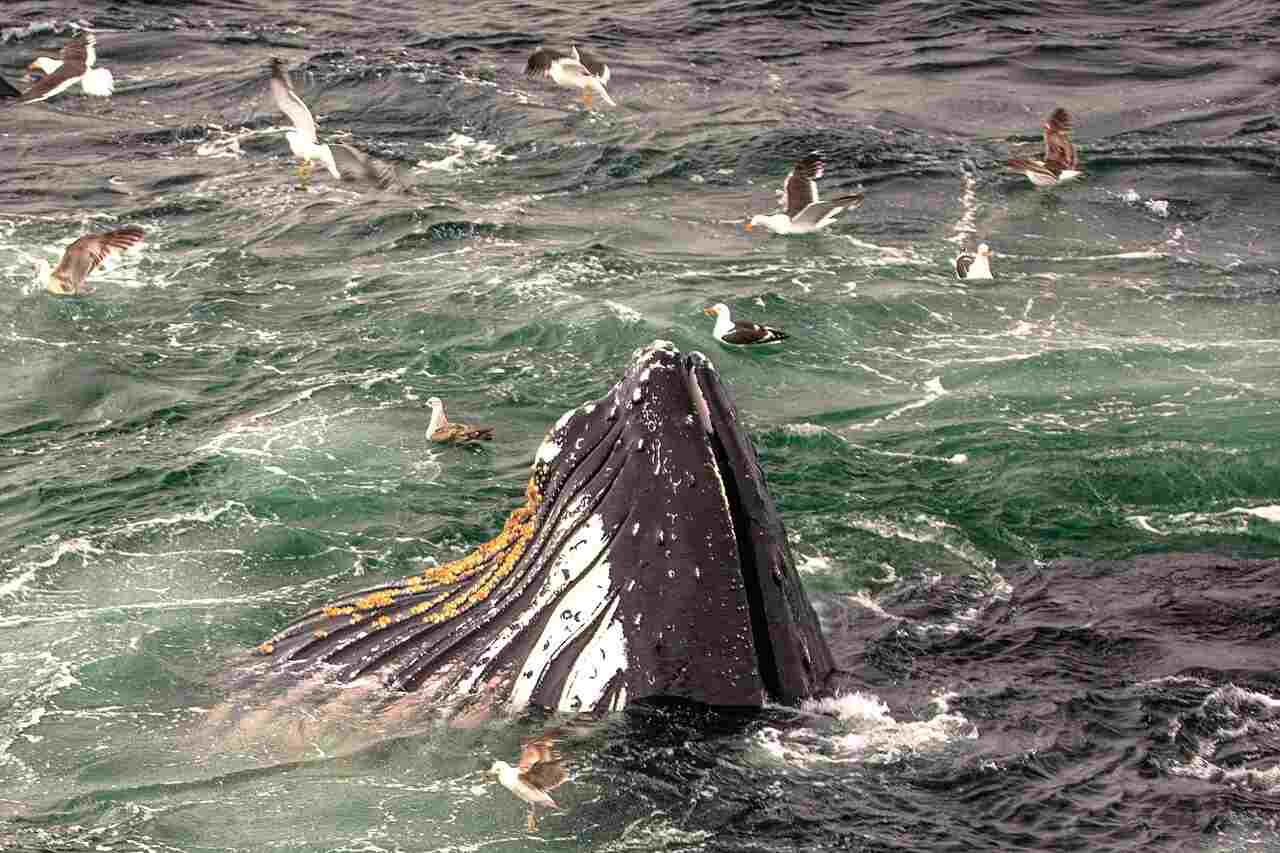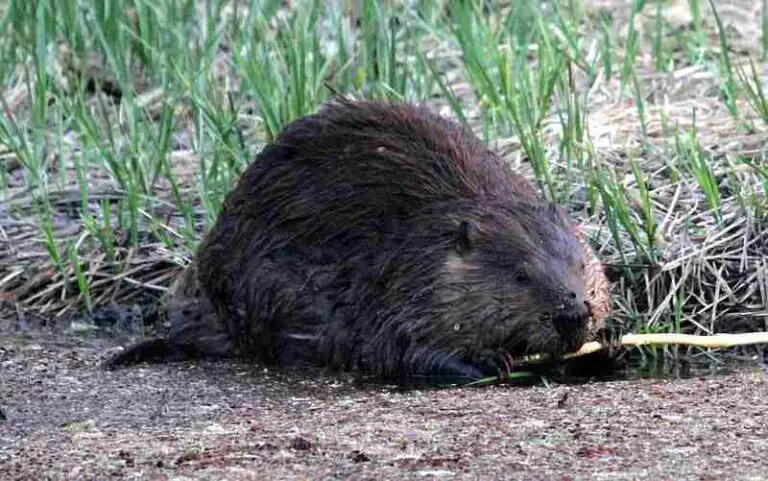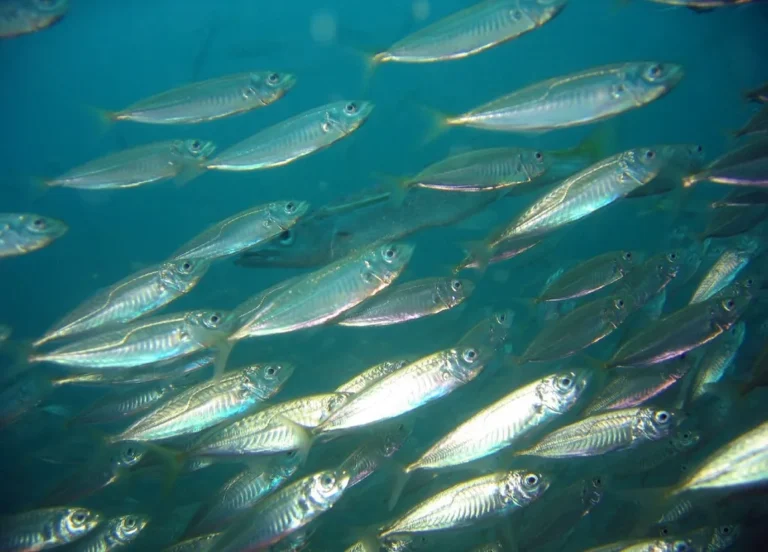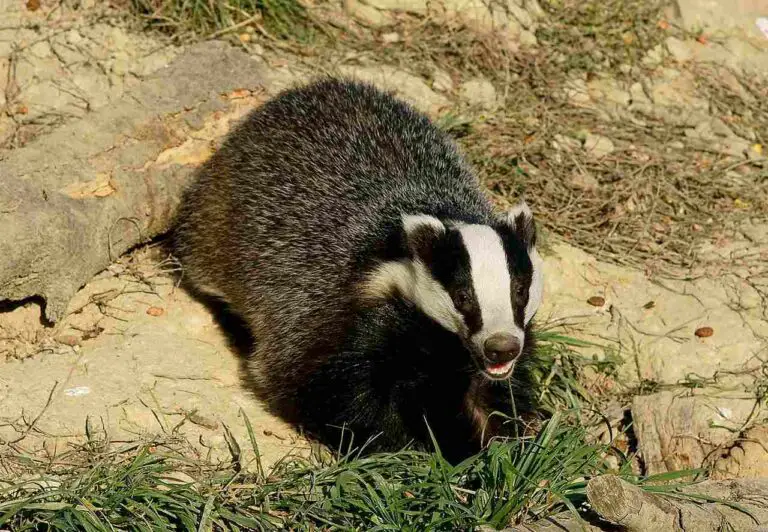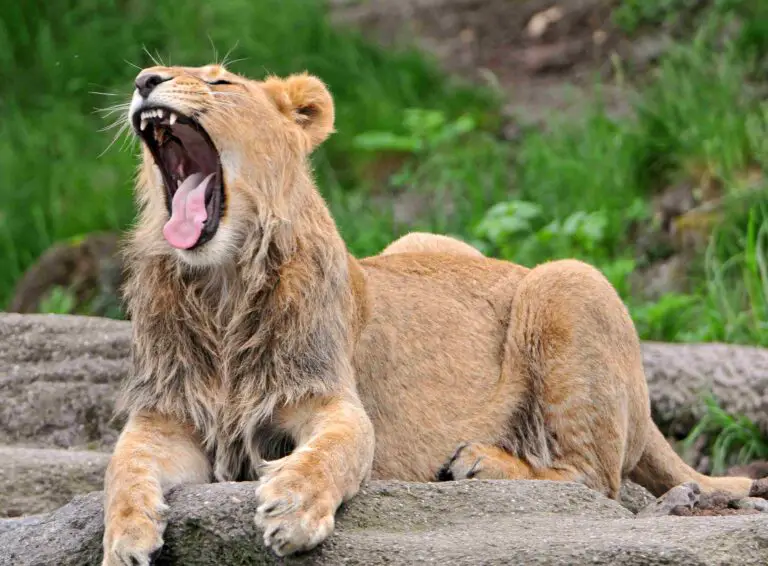15 Atlantic Ocean Biotic and Abiotic Factors Discussed
Atlantic Ocean biotic factors are; autotrophs like phytoplankton, herbivores like krill, carnivores like orca, omnivores like saltwater crabs, decomposers, mutualism, parasitism, and predation.
Atlantic Ocean abiotic factors are; solar radiation, water, physicochemical conditions, physicochemical conditions, sediments, rocks, nutrients, and dissolved gases.
This article discusses Atlantic Ocean biotic and abiotic factors, as outlined below;
Atlantic Ocean Abiotic Factors
-Atlantic Ocean Biotic Factors
1). Autotrophs: One of the Biotic Factors in the Atlantic Ocean
Autotrophs, including phytoplankton, macroalgae, and sea grasses, are essential biotic components of the Atlantic Ocean ecosystem. They perform various crucial functions, some of which are highlighted below for each example mentioned;
1. Phytoplankton
Key functions of phytoplankton in the Atlantic Ocean include photosynthetic biomass production, and oxygen production.
Phytoplankton are primary producers that harness sunlight through photosynthesis to convert carbon dioxide into organic compounds, providing the trophic foundation of the marine food chain.
They release oxygen as a byproduct of photosynthesis, and contribute significantly to the oxygen content in the water.
2. Macroalgae
In the Atlantic Ocean, ecological roles that can be attributed to macroalgae include; habitat abs nursery ground provision, as well as recycling of nutrients.
Macroalgae create diverse habitats, offering shelter and breeding grounds for numerous marine organisms. They contribute to biodiversity by providing niches for various species.
Also, macroalgae play an effective role in nutrient cycling by absorbing nutrients from the water, contributing to the overall balance of chemical compounds and elements in the marine environment.
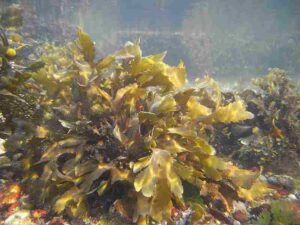
3. Sea Grasses
As primary producers in the Atlantic Ocean ecosystem; sea grasses perform functions such as coastal protection and carbon sequestration.
Sea grasses stabilize coastal ecosystems by reducing erosion through the substrate binding effect of their root systems. They act as a natural barrier against storm surges, safeguarding coastlines.
Typically, sea grasses store carbon in their tissues, contributing to carbon sequestration, increasing the ocean's capacity as a carbon sink, and mitigating the impacts of rising carbon dioxide levels in the atmosphere.
*Collective Impact of Autotrophs in the Atlantic Ocean
Autotrophs collectively ensure the vitality, productivity, and balance of the Atlantic Ocean ecosystem.
Their functions extend beyond individual species, influencing nutrient dynamics, oxygen cycling, and the overall resilience of marine life. These autotrophic organisms are integral to the intricate network of organic relations and survival in the Atlantic Ocean.
2). Herbivores in the Atlantic Ocean
Examples of herbivores in the Atlantic Ocean are; manatees, dugongs, green sea turtles, zooplankton, and herbivorous fish.
These organisms play crucial roles in maintaining the stability and vitality of the Atlantic Ocean ecosystem through various functions. Some of these functions are highlighted in the following discussion;
1. Manatees and Dugongs
The ecological functions of manatees and dugongs include regulation of marine plant populations through seagrass grazing.
Manatees and dugongs are primarily herbivores, and feed on seagrasses. Their grazing activities help control seagrass growth, preventing overgrowth and maintaining the productivity of seagrass beds.
2. Green Sea Turtles
Like manatees and dugongs, green sea turtles help regulate the populations of both plants (vascular and non vascular) and algae in the Atlantic Ocean.
Green sea turtles are herbivores that graze on seagrasses and algae. Their feeding behavior trims seagrass blades and controls algal growth, while influencing the structure and productivity of seagrass ecosystems.
3. Zooplankton
Nutrient cycling facilitation, and algae overgrowth/overpopulation prevention, are both functions that are traceable to zooplankton like krill in the Atlantic Ocean.
Zooplankton, including various small herbivorous organisms, feed on algae in the water column. By consuming algae, they contribute to nutrient cycling and also influence phytoplankton abundance.
4. Herbivorous Fish
Like other herbivores in the Atlantic Ocean, fish are effective grazers that help to regulate the populations of algae and seagrasses.
Herbivorous fish, such as parrotfish and surgeonfish, graze on algae and seagrasses. Their feeding activities regulate algal abundance on coral reefs and seagrass beds, thereby preventing overgrowth.
*Shared Functions and Collective Impact of Atlantic Ocean Herbivores
The shared functions of herbivores in the Atlantic Ocean include nutrient cycling and maintenance of ecosystem structure.
Herbivores contribute to nutrient cycling by consuming plant material and recycling nutrients within the ecosystem.
Also, herbivores influence the structure and composition of marine habitats, from seagrass beds to coral reefs, through their feeding activities.
The collective impact of herbivores in the Atlantic Ocean is notable, and important for maintaining the diversity, structure, and resilience of marine ecosystems. By controlling vegetation and nutrient dynamics, herbivores contribute to ensuring the overall wellbeing and long term sustainability of the Atlantic Ocean ecosystem.
3). Carnivores: One of the Biotic Factors in the Atlantic Ocean
Carnivores in the Atlantic Ocean, include orcas, seals, codfish, walruses, sharks, and rays.
These organisms are known to play vital roles toward maintaining the stability and continuity of the marine ecosystem. They have various functions, some of which are highlighted as follows;
1. Orcas (Also Called Killer Whales)
The main function of orcas in the Atlantic Ocean is predation-based regulation of prey populations and biotic resources.
Orcas can be described as apex predators that help to regulate the populations of other marine species, preventing overgrazing by some herbivorous/omnivorous prey species, and influencing the entire oceanic food web.
2. Seals
The function of seals in the Atlantic Ocean is multidimensional, since they can act as both predators and prey under varying conditions.
Seals serve as a primary food source for apex predators like sharks and orcas, contributing to the energy transfer through the trophic levels. As predatory organisms themselves, they also help to regulate the population size and species richness of lower trophic communities, such as small fish.
3. Codfish
Basically, the codfish is useful to the Atlantic Ocean ecosystem for its role as a regulator of small fish populations.
Codfish, as carnivorous predators, help to control the populations of smaller fish species, and maintain a balance in the abundance of fishery resources within the ecosystem.
4. Walrus
A prominent function of the walrus, in the Atlantic Ocean, is predation on invertebrate populations.
Walruses are known to feed on a variety of invertebrates, which include mollusks and crustaceans. Their feeding activities help to regulate and modify the populations of these invertebrates.
5. Sharks
Like orcas, sharks usually function as apex predators in the Atlantic Ocean ecosystem, so that they are instrumental in the exertion of top-down regulatory effects across all lower trophic levels.
Sharks, as apex predators, play an effective role in regulating the populations of various marine species, such as fish and marine mammals. They help to maintain the overall equilibrium of biotic factors in the marine ecosystem.
6. Rays
Owing to their physiological and behavioral attributes, rays in the Atlantic Ocean are highly effective in the regulation of benthic invertebrate populations.
Rays, particularly those that feed on the ocean floor (benthic rays), help regulate the populations of benthic invertebrates, thereby contributing to the productivity and diversity of the seafloor ecosystem.
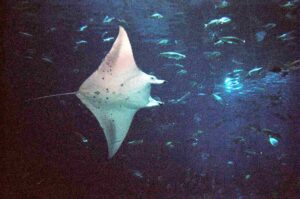
*Shared Functions and Collective Impact of Carnivores in the Atlantic Ocean
The shared functions of carnivores in the Atlantic Ocean include population control, and facilitation of energy transfer.
Carnivores generally regulate the populations of their prey species, thereby preventing resource depletion and maintaining ecological stability.
Also, carnivores facilitate the transfer of energy through the trophic levels by consuming herbivores and smaller predators.
The collective impact of carnivores in the Atlantic Ocean is driven by their shared functions, and contributes to the overall resilience and productivity of the marine ecosystem. By influencing prey populations and maintaining a balance of resources in the food web, carnivores play an indispensable role in sustaining biodiversity and ecosystem stability.
4). Omnivores in the Atlantic Ocean
Omnivores in the Atlantic Ocean include various organisms such as saltwater crabs, lobsters, seagulls, and sea turtles. They contribute to the ecosystem's health and dynamics through a range of functions, which are discussed in this section.
1. Saltwater Crab and Lobster
A core function of saltwater crabs and lobsters in the Atlantic Ocean is nutrient recycling through omnivorous consumption of detrital materials. These organisms can also be described as detritivores, and classified together with decomposers that facilitate biodegradation.
Omnivorous crabs and lobsters play a crucial role in consuming detritus, including decaying organic matter. This helps in nutrient recycling and also maintains water quality.
2. Seagull
In similar manner, some sea birds can help recycle essential resources through scavenging activities. An example of such birds is the seagull, whose ecological flexibility enable it to supplement its predatory feeding habit with occasional scavenging.
Seagulls are opportunistic omnivores that scavenge for food, including fish, invertebrates, and carrion. Their scavenging behavior helps to clean up the ocean surface by removing dead or injured organisms.
3. Sea Turtle
While several species are omnivores, sea turtles are generally effective at regulating autotrophic marine populations through their grazing activities.
Omnivorous sea turtles in the Atlantic Ocean, graze on algae and seagrasses. Their feeding behavior contributes to the health of seagrass beds and controls algal growth, thereby preventing overgrowth that can be harmful to coral reefs.
*Shared Functions and Collective Impact of Omnivores in the Atlantic Ocean
The shared functions of omnivores in the Atlantic Ocean include nutrient cycling, and the facilitation of ecosystem connectivity.
Omnivores participate in nutrient cycling by consuming both plant and animal matter, and subsequently returning essential nutrients to the ecosystem through processes like excretion and decomposition.
Also, omnivores connect different trophic levels by feeding on both primary producers and consumers, thereby influencing the balance of species populations in the ecosystem.
The collective impact of omnivores contributes to the overall resilience and long term sustainability of the Atlantic Ocean ecosystem. By participating in nutrient cycling and maintaining a state of equilibrium in the food web, omnivores support the wellbeing of various marine habitats and organisms.
5). Decomposers: One of the Biotic Factors in the Atlantic Ocean
Decomposers in the Atlantic Ocean include bacteria, marine worms, and echinoderms.
These organisms play effective roles in maintaining the ecosystem's equilibrium and productivity through their various functions. Below are further details;
1. Bacteria
The key function of bacteria in the Atlantic Ocean, is biochemical breakdown/decomposition of organic matter.
Bacteria break down organic matter from dead plants and animals, as well as excrements and other debris, thereby recycling nutrients back into the water. This decomposition process is crucial for nutrient cycling in the ocean.
2. Marine Worms
Marine worms contribute to the cycling of nutrients in the Atlantic Ocean through detritivorous feeding.
Some marine worms specialize in feeding on detritus and decaying organic material on the ocean floor. By consuming dead organisms, they contribute to the breakdown of organic matter.
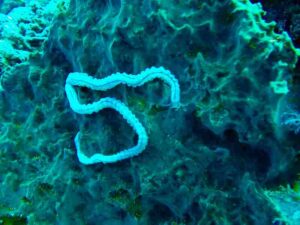
3. Echinoderms
In the Atlantic Ocean, echinoderms facilitate nutrient cycling and energy flow by consuming carrion.
Certain echinoderms, such as sea cucumbers, are detritivores that feed on carrion and organic debris on the seafloor. Their feeding activities contribute to the breakdown of dead organisms.
Shared Functions and Collective Impact of Decomposers in the Atlantic Ocean
Shared functions of decomposers in the Atlantic Ocean are; nutrient recycling and waste decomposition.
Decomposers break down complex organic compounds into simpler forms, in the process releasing nutrients like nitrogen and phosphorus back into the water column This nutrient recycling mechanism is essential for the growth of primary producers.
Also, decomposers help break down and decompose waste materials produced by other organisms, preventing the accumulation of organic matter and excessive pathogen growth, that could negatively impact water quality.
The collective impact of decomposers ensures the efficient recycling of nutrients in the Atlantic Ocean. By breaking down organic matter, decomposers contribute to the availability of essential nutrients for the growth of autotrophs and support the overall productivity and continuity of the marine ecosystem.
6). Mutualism in the Atlantic Ocean
Mutualistic interactions in the Atlantic Ocean involve species that engage in mutually beneficial relationships, which contribute to the overall interconnectivity, resilience and stability of the marine ecosystem.
Examples of mutualism in the Atlantic Ocean include relations between; gobies and mantis shrimps, manta rays and remoras, hermit crabs and sea anemones, groupers with octopuses and moray eels, sea anemone and clownfish. These interactions are each discussed below;
1. Gobies and Mantis Shrimp
The mutualistic relationship between gobies and mantis shrimps is based on cleaning services offered by gobies.
Gobies often form cleaning stations where they remove parasites and debris from the mantis shrimp. In return, mantis shrimp provide protection to the gobies.
2. Manta Rays and Remoras
For manta rays and remoras, their mutualism depends on the exchange of cleaning services for food provision and transportation.
Remoras attach themselves to manta rays, gaining easy transportation and access to food scraps. In return, remoras clean parasites and debris from the manta rays' skin.
3. Hermit Crabs and Sea Anemones
Mutualism between hermit crabs and sea anemones is predicated on the exchange of resources and services like food, mobility and protection.
Hermit crabs seek protection by carrying sea anemones on their shells. The sea anemones, in turn, benefit from the mobility and food particles stirred up by the hermit crab.
4. Groupers with Octopuses and Moray Eels
Predation can also serve as a basis of mutualistic association, as is the case for groupers, octopuses ans moray eels.
Groupers, octopuses, and moray eels sometimes collaborate in hunting. Groupers signal the presence of prey, while octopuses and moray eels flush prey out of hiding, increasing the chances of a successful hunt.
5. Sea Anemone and Clownfish
Exchange of shelter, protection and food resources, is the unifying factor between sea anemones and clownfish.
Clownfish find shelter among the tentacles of sea anemones, gaining protection from predators. The clownfish, in return, provide the sea anemone with food scraps and protection.
*Shared Functions and Collective Impact of Mutualistic Interactions and Organisms in the Atlantic Ocean
For all interactions and organisms, mutualism is instrumental toward the effective exchange of resources, and the insuring of ecosystem stability.
Mutualistic partners exchange resources, such as protection, transportation, or food, thereby enhancing the overall fitness and survival rates of all involved species.
Also, mutualistic interactions contribute to the stability of the Atlantic Ocean ecosystem by fostering interdependence among species and promoting a balance in population and resource dynamics.
The presence of mutualistic relationships enhances the resilience and sustainability of the Atlantic Ocean ecosystem, and highlights both the interconnectedness of species and the importance of cooperation for survival.
7). Parasitism: One of the Biotic Factors in the Atlantic Ocean
Parasitism is a prevalent ecological interaction in the Atlantic Ocean, involving various marine parasites and their hosts.
Key examples of parasitism in the Atlantic Ocean are infection and exploitation of hosts by marine worms, isopods and copepods.
Parasitic worms, isopods, and copepods infect a variety of host species, including crabs and fishes. They derive nutrients and shelter from their hosts, often causing harm or altering the host's behavior.
Nematodes and leeches parasitize various marine organisms, impacting the health of their hosts. Barnacles, although often existing commensally with whales, can act as parasites for other organisms. An example is the infestation of swimming crabs by Sacculina, which control and feed on their host by growing a root-like structure through the crab's reproductive system.
*Functions Shared Across Parasitic Interactions
Some shared functions across different parasitic interactions in the Atlantic Ocean are; nutrient extraction, host manipulation, and population regulation.
Parasites extract nutrients from their hosts, potentially weakening or compromising the host's health.
Some parasites alter the behavior or physiology of their hosts to maximize their chances of survival and reproduction.
*Commensalism Within Parasitism
A hybrid symbiotic relationship bearing attributes of both commensalism and parasitism, can be observed between barnacles and whales in the Atlantic Ocean.
While barnacles often coexist commensally with whales by attaching themselves to the whales' skin and deriving benefits from the whale's movement through nutrient-rich waters, they act as parasites when rooted within the reproductive systems of swimming crabs.
*Impact, Role, and Adaptation Linked to Parasitism in the Atlantic Ocean
Parasitic interactions can have detrimental effects on host organisms, ranging from reduced fitness to altered behaviors. Some parasites may affect host population dynamics.
Also, parasites have a role to play in defining the structure and dynamics of marine ecosystems, by influencing the vitality and abundance of host populations.
Parasites often exhibit specific adaptations, such as specialized structures for attachment or life cycles that optimize their chances of successful parasitism. Similarly, host species may develop counter adaptations to reduce their vulnerability to infestation and morbidity.
The presence of parasitic interactions contributes to the complexity and ecological balance of the Atlantic Ocean, highlighting the interdependence and coevolution of species within the marine ecosystem.
8). Predation in the Atlantic Ocean
Predation is a fundamental ecological interaction in the Atlantic Ocean, involving the hunting and consumption of one organism (the prey) by another (the predator).
Some examples of predators in the Atlantic Ocean include; orcas, seals, codfish, walrus, and sharks. Below is a brief discussion of each of these organisms and their predatory role in the marine ecosystem.
1. Orcas (Killer Whales)
Orcas are apex predators known for their intelligence and complex hunting strategies. They prey on various marine species, including fish, seals, and even other whales.
2. Seals
Seals are carnivorous marine mammals that feed on fish and sometimes squid. They are preyed upon by larger predators, such as sharks and orcas.
3. Codfish
Codfish are predatory fish that play a crucial role in the Atlantic Ocean's food web. They prey on smaller fish and invertebrates, contributing to the regulation of lower trophic levels.
4. Walrus
Walruses are mammalian predators known for their benthic (bottom-dwelling) predation on clams and other mollusks. Their feeding habits influence the structure of benthic communities.
5. Sharks
Various shark species, such as great white sharks and tiger sharks, serve as top predators in the Atlantic Ocean. They feed on a wide range of prey, including fish, seals, and marine mammals.
*Functions of, and Adaptations for Predatory Interactions in the Atlantic Ocean
In the Atlantic Ocean, predation helps to regulate prey population, and facilitate adaptive development by exerting selective pressure on both predators and prey.
Predators help regulate the abundance and distribution of prey species, preventing overpopulation and maintaining ecological balance.
Predation exerts selective pressure on prey populations, driving adaptations such as camouflage, speed, and defensive behaviors.
Trophic bioenergy dynamics in the Atlantic Ocean are also significantly impacted by predation.
Predators occupy different trophic levels, forming intricate food webs that connect primary producers, herbivores, and carnivores. This trophic structure influences energy flow and nutrient cycling in the ecosystem.
Atlantic Ocean predators often exhibit specialized adaptations for hunting, including sharp teeth, powerful jaws, streamlined bodies, and keen senses.
Ecological Significance and Human Impact(s) On Predation in the Atlantic Ocean
The presence of predators contributes to the resilience and diversity of the Atlantic Ocean ecosystem by preventing the unchecked proliferation of certain species and maintaining a balance between predator and prey populations.
Human activities and their implications, such as overfishing and environmental degradation, can disrupt Atlantic Ocean predator-prey dynamics, leading to cascading effects on the entire marine ecosystem. Conservation efforts are needed to preserve the ecological roles of these predators in the Atlantic Ocean.
-Atlantic Ocean Abiotic Factors
1). Solar Radiation: One of the Atlantic Ocean Abiotic Factors
In the Atlantic Ocean, solar radiation is important as an energy resource for temperature regulation, photosynthesis, light energy supply, heat distribution, hydrological cycling, seasonal abiotic regulation, and biotic synchronization.
Solar radiation serves as the primary external energy source for the Atlantic Ocean, driving various ecological processes and supporting marine life.
Direct heating of the ocean surface by solar radiation creates temperature gradients, influencing ocean currents, circulation patterns, and regional climate.
Solar radiation powers photosynthesis in marine autotrophs like phytoplankton and seaweeds, contributing to primary productivity and forming the foundation of the marine food web.
Sunlight availability dictates the distribution of marine organisms, with shallow regions supporting photosynthetic activity and deeper abyssal zones relying on alternative energy sources.
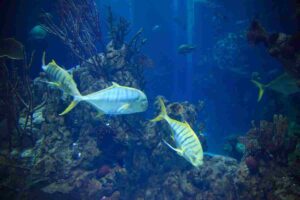
Solar radiation establishes temperature gradients crucial for thermohaline circulation, a deep ocean current that redistributes heat globally.
Also, solar radiation drives evaporation from the ocean, contributing to the water cycle, cloud formation, and precipitation patterns.
Seasonal changes in solar radiation intensity influence temperature fluctuations, seasonal shifts, and the timing of biological events in the Atlantic Ocean.
Solar radiation patterns influence the timing of organic reproductive, migration, and other behavioral aspects of marine animals, thereby synchronizing their life cycles.
Ecological Significance of Solar Radiation in the Atlantic Ocean
Solar radiation is fundamental for biodiversity, as it defines the structure and functioning of the Atlantic Ocean ecosystem, and influences the distribution and behavior of marine life.
The environmental impacts of anthropogenic activities; such as climate change, can alter the absorption and distribution of solar radiation in the ocean, impacting marine ecosystems and necessitating conservation efforts.
2). Physicochemical Conditions in the Atlantic Ocean
In the Atlantic Ocean, physicochemical conditions are important for several reasons which include their influence on salinity conditions, temperature trends, dissolved oxygen levels, nutrient availability, pH balance, light penetration, ionic composition, and ocean stratification.
Physicochemical conditions, especially salinity, have an effective role to play in regulating the density of seawater, influencing ocean currents, and affecting the distribution of marine organisms.
Temperature variations impact other physical properties of seawater, influencing marine life distribution, metabolic rates, and ocean circulation trends.
The amount of dissolved oxygen in the ocean is a vital parameter for the survival of marine organisms, as it influences respiratory processes, and contributes to the structuring of ocean habitats.
Physicochemical conditions control nutrient cycling in the ocean, affecting primary productivity, nutrient availability for marine plants and algae, and subsequently, higher trophic levels.
Ocean acidity, which is influenced by physicochemical conditions, significantly influences marine organisms, especially those with calcium carbonate shells and skeletons, as changes can impact their structure and function.
The transparency of seawater is influenced by physicochemical conditions, which determine the depth to which sunlight can penetrate and, consequently, the distribution of marine plants and organisms.
The ionic composition of seawater affects osmoregulation in marine organisms, influencing their ability to maintain internal balance and adapt to changing environmental conditions.
Physicochemical conditions contribute to the stratification of the ocean, creating distinct layers with varying temperature, salinity, and nutrient levels, influencing marine ecosystems' structure and dynamics.
Physicochemical conditions are ecologically relevant in marine environments, as they collectively determine the ocean's characteristics, shaping the composition, distribution, and behavior of marine life. These conditions are integral to the functioning of the Atlantic Ocean ecosystem.
Anthropogenic activities and their repercussions, like climate change and ocean pollution, can alter physicochemical conditions, leading to disruptions in marine ecosystems and the potential decline of vulnerable species. Conservation efforts are essential to mitigate these impacts.
3). Water: One of the Atlantic Ocean Abiotic Factors
Some factors that reveal the importance and role of water as an abiotic factor in the Atlantic Ocean include its functions as a medium for organic sustenance, thermal regulation, nutrient dissolution/transport, buoyancy and support, oxygen dissolution, as well as hydrological and climatic regulation.
Water is the essential medium that sustains and supports life in the Atlantic Ocean, and provides a habitat for a diverse range of marine organisms, from microscopic plankton to large cetaceans.
It is well known that water has a high heat capacity, which helps to regulate temperature in the Atlantic Ocean. This stability influences marine climates, ocean currents, and the distribution of species adapted to specific temperature ranges.
Water acts as a solvent, facilitating the dissolution and transport of essential nutrients. This supports the growth of phytoplankton and other primary producers, forming the basis of the marine food web.
The buoying effect of water provides support for marine organisms, allowing them to float, swim, and navigate the ocean environment. It is particularly crucial for the survival of planktonic organisms.
Water currents transport nutrients, heat, and marine organisms across vast distances, influencing the connectivity and distribution of species in the Atlantic Ocean.
Also, water is required for dissolving oxygen, which is itself crucial for the respiration of marine life. Dissolved oxygen levels influence the distribution and behavior of fish and other marine organisms.
Water in the Atlantic Ocean participates in the hydrological cycle, contributing to processes such as evaporation, precipitation, and runoff. This cycle influences weather patterns and nutrient cycling in marine ecosystems.
The vastness of the water masses that make up the Atlantic Ocean, moderates temperature extremes, and provides a stable environment for marine life. This buffer is essential for the adaptation and survival of diverse species.
With regards to its ecological significance, it can be said that water is the foundation of the Atlantic Ocean ecosystem, influencing its physical and chemical characteristics. It defines the distribution, behavior, and adaptations of marine organisms, thereby contributing to the biodiversity and ecological dynamics of the region.
Human-induced impacts, such as habitat deterioration and global warming, can alter the composition and properties of ocean water, thereby affecting marine life. Conservation efforts are required to mitigate these impacts and preserve the integrity of the Atlantic Ocean ecosystem.
4). Sediments in the Atlantic Ocean
As an abiotic factor in the Atlantic Ocean, sediments provide a habitable substrate for benthic organisms, supports nutrient storage and recycling, facilitates carbon sequestration, detoxification of the water column, physical stability, and supports ecological niches like coral reefs and kelp forests. These ecological functions are outlined below;
Sediments on the ocean floor provide a substrate and habitat for a diverse array of benthic organisms. Infauna, such as worms and small crustaceans, thrive in the sediments, contributing to benthic biodiversity.
Typically, sediments accumulate organic matter and nutrients, serving as a reservoir for essential elements. Bacteria in the sediments have a vital role to play in recycling nutrients, supporting primary production in overlying water.
Sediments act as an effective sink for organic carbon, aiding in the sequestration of carbon from the water column. This process contributes to the regulation of carbon cycling and the mitigation of climate change impacts.
Sediments can absorb and immobilize contaminants, acting as a natural filtration system that helps detoxify the surrounding water. This function is critical for maintaining water quality and reducing the impact of pollutants.
In general, sediments contribute to the physical stability of the ocean floor. They directly influence erosion and sediment resuspension, and may provide a stable environment for benthic organisms and habitats.
Sediments accumulate over time and can serve as archives of environmental history. By studying sediment layers, scientists can gain insights into past climatic conditions, human activities, and changes in the Atlantic Ocean ecosystem.
In areas where coral reefs and seagrasses thrive, sediments provide a foundation for their attachment and growth. The stability offered by sediments is essential for the establishment and maintenance of these critical ecosystems.
Lastly, sediments play a role in shaping ocean dynamics, including currents and circulation patterns. They contribute to the transport of materials across the ocean floor, influencing nutrient distribution and connectivity.
Based on their multiple ecological roles, sediments are integral to the functioning of the Atlantic Ocean ecosystem. They support diverse ecological processes, which range from nutrient cycling to the maintenance of benthic communities, contributing to the overall health and biodiversity of the marine environment.
Human activities, such as bottom trawling and sediment dredging, can disrupt sediment ecosystems and lead to habitat degradation. Sustainable management practices are needed to mitigate these stressors and protect the ecological functions of sediments in the Atlantic Ocean.
5). Rocks: One of the Atlantic Ocean Abiotic Factors
In the Atlantic Ocean; rocks are important for various reasons, which include their role as a habitat for marine life, a contributor to biodiversity, coral reef formation, wave energy regulation, erosion control, carbon cycling, sequestration, and overall geologic development.
Rocks on the ocean floor provide a substrate for the attachment of various marine organisms, including sponges, corals, and algae. These rocky habitats create diverse ecosystems and support a wide range of marine life.
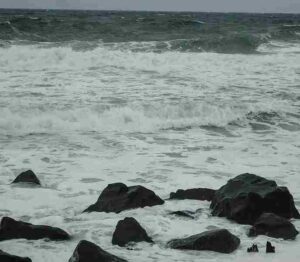
Rocky outcrops serve as biodiversity hotspots, which foster the growth of diverse and specialized communities of flora and fauna. The complex structure of rocks offers niches for various organisms, contributing to overall marine biodiversity.
Certain types of rocks, such as limestone and volcanic rocks, are highly instrumental in coral reef formation. Coral colonies attach to these substrates, forming the foundation for expansive and ecologically rich reef ecosystems.
Coastal rocks act as natural wave breakers, dissipating the energy of waves and protecting shorelines from erosion. They contribute to the stability of coastal ecosystems and provide a buffer against the impacts of storms.
Underwater geologic features, including seamounts and ridges, influence ocean currents and circulation patterns. Rocks contribute to the shaping of these features, impacting the overall dynamics of the Atlantic Ocean.
Certain rocks, especially those rich in calcium carbonate, play a role in carbon cycling. They can contribute to the absorption of carbon dioxide from seawater, influencing oceanic carbon dynamics and participating in global carbon sequestration.
Rocks in the Atlantic Ocean can contain valuable information about Earth's geological history. By studying rock formations, scientists can gain insights into past tectonic activities, climatic conditions, and the evolution of ocean basins.
As abiotic factors, rocks form integral components of the Atlantic Ocean ecosystem, supporting diverse habitats and influencing oceanographic processes. They contribute to the resilience and long-term functionality of marine environments.
Human activities, such as deep-sea mining and their consequences such as habitat destruction, can negatively impact rocky ecosystems. Deliberate measures to reduce such activities and impacts are often necessary for protecting these habitats and ensuring the sustainable use of marine resources in the Atlantic Ocean.
6). Nutrients in the Atlantic Ocean
The functions of nutrients in the Atlantic Ocean are numerous and range from supporting primary production to fostering biological continuity, ecosystem dynamics, biodiversity, food web structuring, regulation of algal blooms, calcium carbonate formation, and carbon sequestration. Below is an outline that further elaborates these functions;
Nutrients, such as nitrogen, potassium, sulfur and phosphorus, are essential for the growth of phytoplankton—the primary producers in the ocean. These microscopic plants form the foundation of the marine food web, supporting diverse aquatic life.
The availability of nutrients directly influences the overall biological productivity of the Atlantic Ocean. Adequate nutrients sustain the growth of planktonic organisms, which, in turn, support higher trophic levels, including fish and marine mammals.
Nutrient cycling is a key driver of ecosystem dynamics. The recycling of nutrients through biological processes, such as nutrient uptake by organisms and decomposition of organic matter, maintains a balance within the marine environment.
Also, nutrients contribute to the biodiversity of the Atlantic Ocean by influencing the composition and abundance of species. They are crucial for the development and maintenance of complex food webs, ensuring a variety of interactions among different organisms.
Nutrient levels play an effective role in controlling algal blooms. Excessive nutrient input, often due to anthropogenic activities and systems like agriculture and industrial waste outlets, can lead to harmful algal blooms, disrupting marine ecosystems and causing negative ecological impacts.
Some nutrients, particularly calcium and carbonate ions, contribute to the formation of calcium carbonate structures, such as shells and skeletons of marine organisms like corals, mollusks, and foraminifera. This process is vital for the construction of coral reefs and other carbonate-rich habitats.
Lastly, nutrients influence the biological uptake of carbon in the ocean. Phytoplankton, by utilizing nutrients for photosynthesis, contribute to carbon sequestration, thereby playing a role in regulating atmospheric carbon dioxide levels.
Generally, nutrients are fundamental to the vitality and functioning of the Atlantic Ocean ecosystem, by supporting the intricate interplay of organisms and influencing the overall structure and dynamics of marine communities.
Anthropogenic factors, such as agricultural influence and nearby urbanization, can lead to nutrient imbalances, contributing to issues like eutrophication. Sustainable nutrient management is crucial for maintaining the health of the Atlantic Ocean.
7). Dissolved Gases: One of the Atlantic Ocean Abiotic Factors
In the Atlantic Ocean, nutrients constitute an important abiotic factor that determines oxygen supply, respiration and metabolism, pH regulation, photosynthetic processes/trends, carbon cycling, thermoregulation, denitrification and nutrient cycling.
Dissolved oxygen is vital for the survival of marine organisms, particularly aerobic species. It supports the respiratory processes of fish, invertebrates, and other marine life, influencing their distribution and abundance.
Some dissolved gases, especially oxygen and carbon dioxide, are integral to the respiratory and metabolic processes of marine organisms. They facilitate the breakdown of organic matter and transfer of energy within the ecosystem.
Also, dissolved gases like carbon dioxide, are instrumental in regulating the pH of seawater. The carbon dioxide equilibrium affects the acidity of the ocean, influencing the physiology of marine organisms, especially those with calcium carbonate structures.
Dissolved gases, particularly carbon dioxide, are essential for the process of photosynthesis in marine plants, including phytoplankton and macroalgae. This process contributes to the production of organic matter and the release of oxygen.
Dissolved gases that contain elemental carbon, contribute to carbon cycling in the ocean. Marine organisms take up and release carbon dioxide through respiration and photosynthesis, influencing the overall carbon balance and the ocean's role in climate regulation.
Dissolved gases, such as oxygen, are involved in thermoregulation for marine organisms. Temperature and oxygen levels influence the metabolic rates of organisms, affecting their growth, reproduction, and overall ecological function.
Lastly, dissolved gases, including nitrogen compounds, are essential for nitrogen cycling. Bacteria in oxygen-deprived zones carry out denitrification, converting nitrates into nitrogen gas, contributing to nutrient cycling in the ocean.
The above discussion shows that dissolved gases are critical components of the Atlantic Ocean's abiotic environment, and may influence the behavior, distribution, and ecological interactions of marine organisms.
As is the case for other abiotic factors, anthropogenic activities, such as nutrient runoff and climate change, can alter the dissolved gas composition in the ocean, thereby leading to challenges like ocean acidification and hypoxia. Sustainable management is crucial for preserving the integrity of dissolved gas dynamics in the Atlantic Ocean.
Conclusion
Atlantic Ocean biotic factors are;
Autotrophs
Herbivores
Carnivores
Omnivores
Decomposers
Mutualism
Parasitism
Predation
Atlantic Ocean Abiotic Factors are;
Solar Radiation
Water
Physicochemical Conditions
Sediments
Rocks
Nutrients
Dissolved Gases

